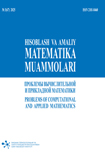Вырожденные отображения Лотки-Вольтерры и соответствующие им биграфы как дискретная модель эволюции взаимодействия двух вирусов
DOI:
https://doi.org/10.71310/pcam.3_67.2025.02Ключевые слова:
отображение Лотки-Вольтерры, симплекс, кососимметричная матрица, выпуклая оболочка, траектория, частично ориентированный граф, биграфАннотация
В работе предлагается дискретная модель взаимодействия двух воздушно-капельных вирусов, основанная на операторе Лотки-Вольтерры, действующем в четырёхмерном симплексе. Эта модель описывает развитие эпидемического процесса в замкнутой популяции, разделённой на пять классов: восприимчивые, находящиеся в латентной стадии первого вируса, инфицированные первым вирусом, инфицированные вторым вирусом и выздоровевшие после первого вируса. Математическая структура модели учитывает сложные переходы между состояниями и взаимодействие штаммов, включая случаи коинфекции. Особое внимание уделено анализу множества начальных и конечных состояний болезни, определяемых системой неравенств. В зависимости от параметров модели эти множества могут лежать на различных гранях симплекса, что соответствует различным сценариям начала и окончания эпидемии. Рассматриваются два ключевых эпидемиологических сценария: один с полным выздоровлением после первого вируса, другой — с переходом инфицированных первым вирусом в состояние коинфекции с невозможностью полного выздоровления. Модель применима к анализу коинфекции туберкулёза с вирусными гепатитами B и C и позволяет оценивать влияние различных параметров на выживаемость пациентов при многокомпонентной терапии. В заключении проведён численный эксперимент: представлены траектории, фазовые портреты и 30-дневная динамика распространения заболевания, иллюстрирующие поведение системы при различных начальных условиях и параметрах.
Библиографические ссылки
Ganikhodzhaev R.N. and Eshmamatova D.B. 2006. Quadratic automorphisms of a simplex and the asymptotic behavior of their trajectories Vladikavkaz. Mat. Zh. – Vol. 8. – P. 12–28.
Ganikhodzhaev R.N., Tadzhieva M.A. and Eshmamatova D.B. 2020. Dynamical Proporties of Quadratic Homeomorphisms of a Finite-Dimensional Simplex Journal of Mathematical Sciences – Vol. 245. – P. 398–402.
Ganikhodzhaev R.N. 1993. Quadratic stochastic operators, Lyapunov function and tournaments Acad. Sci. Sb. Math. – Vol. 76 – P. 489–506.
Harary F. 1969. Graph Theory Addison-Wesley.
Moon J.W. 2013. Topics on Tournaments.
Eshmamatova D.B., Tadzhieva M.A., Ganikhodzhaev R.N. 2023. Criteria for the Existence of Internal Fixed Points of Lotka-Volterra Quadratic Stochastic Mappings with Homogeneous Tournaments Acting in an (m-1)-Dimensional Simplex Journal of Applied Nonlinear Dynamics. – Vol. 12 – P. 679–688. doi: http://dx.doi.org/10.5890/JAND.2023.12.004.
Eshmamatova D.B., Tadzhieva M.A. and Ganikhodzhaev R.N. 2022. Criteria for internal fixed points existence of discrete dynamic Lotka–Volterra systems with homogeneous tournaments Izvestiya Vysshikh Uchebnykh Zavedeniy. Prikladnaya Nelineynaya Dinamika. –Vol. 30 – P. 702–716. doi: http://dx.doi.org/10.18500/0869-6632-003012.
Murray J.D. 2009. Mathematical biology Springer.
Kermack W.O., McKendrick A.G. 1927. A contribution to the mathematical theory of epidemics Proceedings of the Royal Society of London. Series A, Containing Papers of a Mathematical and Physical Character. – Vol. 115 – P. 700–721.
Murray Y.D. 2004. On a necessary condition for the ergodicity of quadratic operators defined on a two-dimensional simplex // Marh. Surv. – Vol. 59 – P. 571–573.
Eshmamatova D.B., Ganikhodzhaev R.N. 2021. Tournaments of Volterra type transversal operators acting in the simplex ????????−1 // AIP Conference Proceedings. - 2365, 060005-1-060005-7 (3. Scopus. IF=0.16). doi: http://dx.doi.org/10.1063/5.0057303.
Eshmamatova D.B., Tadzhieva M.A. and Ganikhodzhaev R.N. 2021. Degenerate cases in Lotka–Volterra systems AIP Conference Proceedings. – Vol. 2781. 020034-1-8 (3. Scopus. IF=0.16). doi: http://dx.doi.org/10.1063/5.0144887.
Eshmamatova D.B. 2023. Discrete analog of the SIR model AIP Conference Proceedings. – Vol. 2781. 020024-1-10 (3. Scopus. IF=0.16). doi: http://dx.doi.org/10.1063/5. 0144884.
Eshmamatova D.B., Seytov Sh.J., Narziev N.B. 2023. Basins of Fixed Points for Composition of the Lotka–Volterra Mappings and Their Classification. Lobachevskii journal of mathematics. – Vol. 44. – P.558–569. doi: http://dx.doi.org/10.1134/S1995080223020142.
Eshmamatova D.B., Ganikhodzhaev R.N. and Tadzhieva M.A. 2022. Dynamics of Lotka-Volterra quadratic mappings with degenerate skew-symmetric matrix Uzbek Mathematical Journal. – Vol. 66 – P. 85–97.
Jiang Xu, Yinong Wang and Zhongwei Cao 2021. Dynamics of a stochastic SIRS epidemic model with standard incidence under regime switching International Journal of Biomathematics. – Vol. 2781. – 2150074 p.
Korobeinikov A., Maini P.K. 2004. A Lyapunov function and global properties for SIR and SEIR epidemiological models with nonlinear incidence Mathematical Biosciences and Engineering. – Vol. 1. – P. 57–60. doi: http://dx.doi.org/10.3934/mbe.2004.
Jin X., Jia J. 2020. Qualitative study of a stochastic SIRS epidemic model with information intervention // Physica. – Vol. 123866. – 547 p.

Загрузки
Опубликован
Выпуск
Раздел
Лицензия
Copyright (c) 2025 У.Р. Муминов

Это произведение доступно по лицензии Creative Commons «Attribution» («Атрибуция») 4.0 Всемирная.



